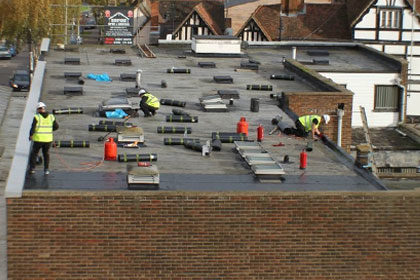 What Types of Felt Are Used for Roofing?
What Types of Felt Are Used for Roofing?
You may think of your roofing materials as restricted to tiles, slates or perhaps metal sheets. However, the felt underlay is every bit as vital for the roof to do its job properly — and, if you have a flat roof, a type of felt may be the primary material.
What Is Roofing Felt For?
Apart from being the basic material for many flat roofs, felt is used as the underlay for pitched roofs. Mortar used to meet this requirement but felt underlay has been the preferred method for about fifty years. So, unless you have a very old roof, the likelihood is that there’ll be felt beneath your tiles or slates.
The main purpose of the underlay is to keep out water, as well as fulfilling building regulations. If moisture gets through cracked or missing tiles, it could cause damp, mould and mildew in the roof space, potentially spreading down through the house.
Felt underlay provides a waterproof barrier to prevent moisture from getting in. At the same time, it helps the roof space insulation to prevent heat from escaping through the roof.
Types of Felt Underlay for Pitched Roofs
The original material for roofing felt was bitumen sarking felt, which is mounted on a strong woven base. This is effective in the short term, but it can become brittle with age, especially if it’s exposed to sunlight.
More modern types of felt underlay are broadly divided into two types:
HR (High Water Vapour Resistance) Underlays — As the name suggests, HR underlays are highly effective at waterproofing your roof. The main downside is that the same properties prevent the membrane from breathing, so you’ll need to build ventilation into your roof space.
LR (Low Water Vapour Resistance) Underlays — Classified either as Air Tight or Air Permeable, LR underlays are constructed in layers that allow for greater ventilation, but with the disadvantage of being a little less waterproof than HR underlays. In general, the Air Permeable types are both less waterproof and better for ventilation than the Air Tight ones.
Roofing Felt for Flat Roofs
Bitumen felt can also be used as the main material for constructing flat roofs. In the traditional method, the bitumen is melted and poured over a base membrane. Alternatively, the torch-on type of bitumen felt comes ready made in rolls that can be spread out over the flat roof.
If you need to have your roof replaced, and the felt underlay or flat-roof felt with it, the best felt for your roof will depend very much on the type of roof you have. However, it will also depend on the ventilation needs of your roof space. Get in touch with us to find out more about what type of felt be best for your roof.









